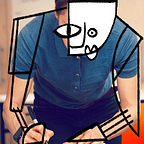Curiouser and curiouser — 5 immersive rabbit holes to explore
With a curious mind and tantalising smorgasbord of ‘research, play and make’ routes to explore, I’m hoping to make new and unexpected connections in the world of immersive media.
Through a series of experimental playful prototypes documented and shared via this blog I intend to attempt to answer the following questions:
“What makes an experience really immersive?” and “What’s the special recipe for leaving its delicious sticky residue permanently imprinted on your brain?”
From touchy to feely
As a digital product designer I mostly design flat 2D experiences for screens. The ‘sensory’ experience is limited mostly to sight and finger touch and typical user journeys are composed of images and text, with a bit of animation and film thrown in if I’m lucky. After almost 20 years, it’s beginning to feel like groundhog day time for an affair.
I’m seduced by the physicality of an immersive experience that might require a radically different approach to design.
From finger to toe, the body and our senses have potential to play a greater part in how we interact and experience things. The prospect of using different body parts tempts my imagination and opens up a whole heap of enticing questions:
How might I use other parts of the body, not just our hands to explore a space? How might I use gestures to encourage exploration, curiosity and play? How might I use smell, sound, and light to create specific atmospheres? How might someone discover how to interact with something when there are no instructions?
Furry tales
Whether it’s a graphic novel, science fiction book or film, podcast or tv series, I love nothing more than being whisked away to explore strange new worlds, rich with mystery and possibility.
Inspired by the books I read as a child by Roald Dahl and Spike Milligan, I have even dipped a toe myself and written a handful of stories and silly poems. But what makes a narrative feel immersive and how might this translate to a physical sensory experience?
What are the different ways stories might be experienced physically? What are the ‘textures’ of a story? How might technology be used to support, affect, embody, and translate the story? What are the stories I really want to tell? Which aspects of the story do I want to bring to life?
Playing to learn, learning to play
The games industry is BOOMING right now. Not a surprise since we’re in the middle of a pandemic and games provide a magical alternate reality.
I feel there’s a lot to learn from games; both playing and making them, and in my approach to learning new skills. I’m intrigued to see what might emerge if I switch my mindset from ‘learning’ to ‘playing’ instead. Just like a child would.
How might I adopt a more playful approach to learning new technologies, tools and techniques? What is it about the suspension of reality that games create that is so enticing and more-ish? How might I attempt to create some of that magic myself? What makes something game-like or playful? How might I use technology in playful ways to create some magic and wonder?
Impossibly possible
I’m a dreamer and a doodler. I fill sketchbook after sketchbook with strange characters, scenes and surreal contraptions, trapped between the pages. Until now.
I’m excited by the possibility that, through emerging technologies, I’m on the brink of breathing life into them, creating moments of magic that would be impossible to experience in this world as we know it. That I might make something impossible, feel totally real.
How might I hide the technology and make these experiences feel like magic? How might I create an experience that appears to break the laws of physics? How might I push the limitations of site-specific Virtual / Augmented/ Mixed Reality through illusions of space and time? Could I imagine new ways of experiencing ‘Escape Rooms’?
Feeding the immersive beast
Experimental playful prototypes are the mini beasts of ideas and need nourishment. I’ll need a constant stream of character, story and game ideas and ways to feed, nurture and play with them.
I have tried and tested methods for designing digital experiences at my disposal. But in this new arena, what are my tools for designing playful immersive experiences?
How might I use techniques developed in my own artistic practice? Can I make it playful and fun to collaborate with others, perhaps even magical? How might I create ‘pots of food’ for my mini-beasts to feed on? Is there a system that keep things changing and evolving, responding to new ideas as they arrive in my brain?
So with my head wrapped around these 5 threads, I set out with a spirit of curiosity and play, and on the hunt for willing participants to play with me and my beasts.
First stop. Start playing with myself…
This article is part of a series documenting my journey as a UX designer and artist into the world of immersive experience.
Read about why I’m doing this here.
